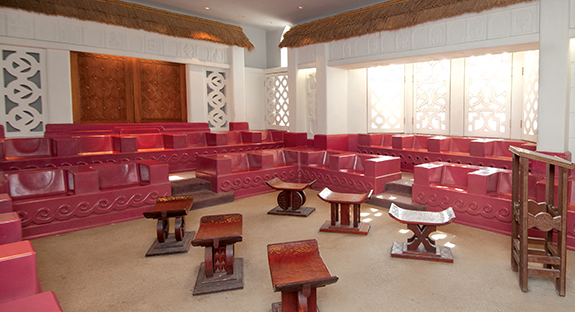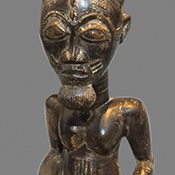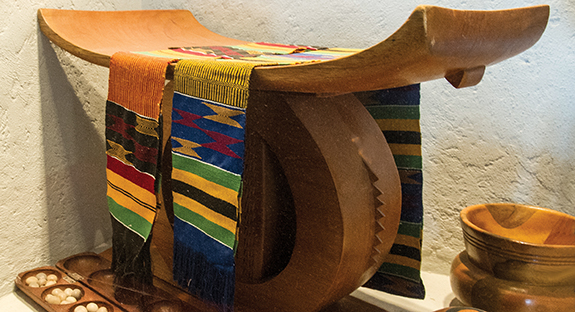Africa’s Cultural Diversity, Embodied in the Artifacts and Design of One Room
 Within the University of Pittsburgh’s African Heritage Classroom, Pitt alumnus Ralph Proctor (A&S ’65, ’79G) handles the helmet mask with great care. He describes its origin with enthusiasm and in precise detail.
Within the University of Pittsburgh’s African Heritage Classroom, Pitt alumnus Ralph Proctor (A&S ’65, ’79G) handles the helmet mask with great care. He describes its origin with enthusiasm and in precise detail.
Carved from a single piece of wood and covered in antelope skin, the helmet mask was worn by Ekoi tribesmen, tasked with protecting their village from invaders. The Ekoi, also known as the Ejagham, were a large and influential people in what is now the nation of Cameroon.
The mask is a gift from Proctor, a professor of ethnic and diversity studies at the Community College of Allegheny County, to the African Heritage Classroom. It is one of eight artifacts he has donated this year. To commemorate Black History Month and the legacy of the African Heritage Classroom, Proctor makes an annual contribution of African art each February to the Heritage Room—one of the 29 Nationality and Heritage Rooms located in the Cathedral of Learning.
Proctor’s other 2014 Black History Month donations include a priest’s wooden whistle, played by Chokwe religious leaders in Angola during royal ceremonies and parades; a bronze altar bell, used by the Yoruba people in Nigeria during ceremonies involving their king; and a wood and leather ceremonial pipe, which was smoked by the Council of Elders of the Ibibio people to send prayers to heaven during ceremonies and tribal rituals.
E. Maxine Bruhns, director of the Nationality Rooms and Intercultural Exchange Programs, said Proctor’s donations are welcome additions to the diversity that defines the African Heritage Classroom.
“Ralph Proctor’s annual donation of rare, priceless pieces of art work are not only historically significant but they come from a wide collection of eras, regions, and societies,” said Bruhns.
Bruhns has overseen the installation of 10 Nationality and Heritage Classrooms, including the African Heritage Classroom, during her 49-year tenure as program director. “The African Heritage Classroom is different from other Nationality Rooms because it represents the cultures of an entire continent, not just one nation. These artifacts fit with the theme of cultural diversity that we’ve worked tirelessly to establish and maintain within this Heritage Room over the years.”
has overseen the installation of 10 Nationality and Heritage Classrooms, including the African Heritage Classroom, during her 49-year tenure as program director. “The African Heritage Classroom is different from other Nationality Rooms because it represents the cultures of an entire continent, not just one nation. These artifacts fit with the theme of cultural diversity that we’ve worked tirelessly to establish and maintain within this Heritage Room over the years.”
The African Heritage Classroom’s design portrays a central courtyard typical of 18th century Asante temples in Ghana. Across the African continent, courtyards symbolize the significance of community, family, and spiritual worship in the lives of Africans. Bruhns points to the room’s entry door—which depicts scenes from nine African civilizations—as well as the Heritage Room’s display case, where Proctor’s donations will be on rotating display throughout the year.
Proctor proudly holds up two Yoruba statues called “Dwelling Houses for the Soul of a Twin.” The Yoruba people, who had a high twin birth rate, believed the figurines protected the soul of a deceased twin until the death of the other sibling. The figures were kept in the home of close family members following the death of the second twin.
“I have had the good fortune to enjoy the beauty of African art, like the Dwelling House Twins and the Helmet Mask, for most of my adult life, and I wanted to share my collection with people who would appreciate it most,” said Proctor, who has spent more than 40 years researching ancient African civilizations. “As a proud graduate of Pitt, I have a vested interest in the University, and I thought there would be no better setting to display the art than a classroom that was designed to be a tribute to African culture.”
The African Heritage Classroom will celebrate its 25th anniversary in December. Early in the room’s development phases, it was decided that the Heritage Room would stand as a monument to the “history, wealth, and diversity of African culture.”
Pitt History professor Laurence Glasco has played an active role in the African Heritage Classroom’s development. He chaired the committee that conceptualized the room’s final design in 1985 and in 1987, he travelled to Nigeria and Ghana to research and photograph traditional Yoruba and Asante temples. Glasco’s many years of service to the Heritage Room was the original inspiration behind Proctor’s donations.
Glasco said Proctor’s donation is the latest contribution from Pittsburgh’s African American community, which over the years has worked together to make the African Heritage Room a reality.
said Proctor’s donation is the latest contribution from Pittsburgh’s African American community, which over the years has worked together to make the African Heritage Room a reality.
“It would be safe to say that there would not be an African Heritage Classroom, if it were not for the efforts and generosity of Black Pittsburghers like Ralph Proctor,” said Glasco. “We’re not just talking about affluent African Americans, we’re talking about the entire Black community. The African Heritage Classroom is the result of an entire community coming together for a common good, a common purpose.”
The initial funding for the Heritage Room is indicative of the grass roots efforts by Pittsburgh’s Black community: Pitt’s Black Action Society (BAS) donated $208.95—collected at a BAS dance—in November 1973.
Under the leadership of the first Chairman of the African Heritage Classroom Committee Walter Worthington as well as Pitt alumnus Nancy H. Lee (EDUC ’27, SOC WK ’43G), the room’s longtime campaign planning coordinator, more than $150,000 would be raised over the course of 17 years. The majority of funding came from Pitt alumni, faculty, and staff as well as from such notable local organizations as Pittsburgh’s African American Chamber of Commerce, Alpha Kappa Alpha Sorority, Delta Sigma Theta Sorority, the NAACP, the National Association of Negro Business and Professional Women, and St. Benedict The Moor School, among numerous other regional organizations.
The African Heritage Classroom Committee sponsored several fundraising events, including one evening in 1975 when more than 1,000 guests contributed to hear author and historian Alex Haley deliver a lecture on his African ancestry, prior to the publishing of his renowned book Roots: The Saga of an American Family (DoubleDay, 1976).
“The African Heritage Classroom, to me, embodies the pride that I and people like me feel about our ancestry,” said Proctor. He stands next to a throne made of wood, metal, and hyena hide that was used by Chokwe Chieftains during outdoor ceremonies. Such an item is highly valued and rarely sold or given away. But now, thanks to Proctor, it belongs to Pitt’s African Heritage Classroom.
“I am making these contributions,” adds Proctor, “because I want Pitt students and anyone else who sets foot in that room to know that our ancestry is just as noble and proud as any other in the history of the world.”
Other Stories From This Issue
On the Freedom Road

Follow a group of Pitt students on the Returning to the Roots of Civil Rights bus tour, a nine-day, 2,300-mile journey crisscrossing five states.
Day 1: The Awakening
Day 2: Deep Impressions
Day 3: Music, Montgomery, and More
Day 4: Looking Back, Looking Forward
Day 5: Learning to Remember
Day 6: The Mountaintop
Day 7: Slavery and Beyond
Day 8: Lessons to Bring Home
Day 9: Final Lessons

